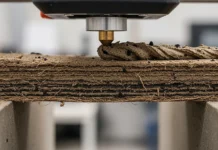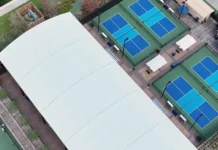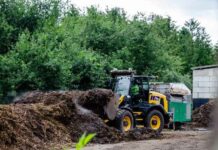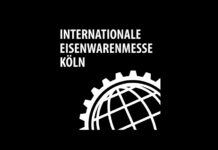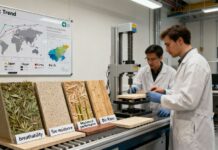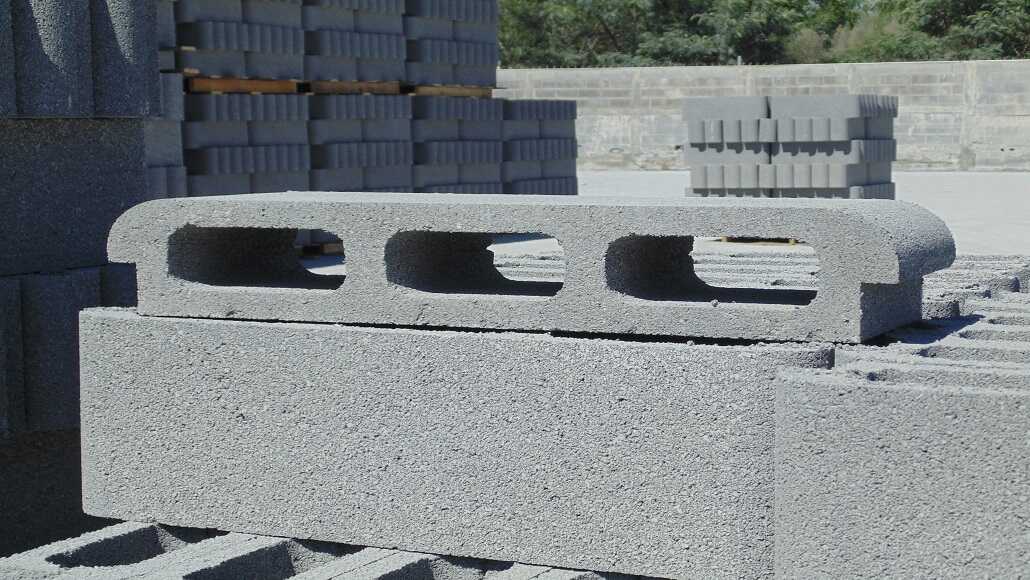Natural resources go on to form the foundation of life on earth, thereby supporting both the present as well as future generations. These resources, however, are numbered, thereby necessitating their sustainable management in order to preserve the health of the planet. Sustainability has gone on to become a very crucial concept throughout industries, especially in construction, which prominently contributes towards global carbon dioxide emissions. It is well to be noted that the building sector comprises almost 30% of the global CO₂ emissions, which is due to fossil fuel-based raw materials, outdated techniques, extended supply chains, and waste disposal practices that are completely dependent on landfills.
Concrete happens to be very important in construction and ranks as the second most utilized material across the world after water. Its major components – sand, cement, and water—happen to come at an environmental cost. Cement production is responsible for almost 8% of the global CO2 emissions because of its energy-intensive methods.
Although the concrete offers very high compressive strength, it apparently is weak in tension, thereby needing reinforcement, which is traditionally achieved by way of steel. However, the susceptibility to corrosion when it comes to steel demands a thick protective cover, thereby leading to an elevated material usage and associated environmental effect.
In response to this modern construction puts stress on environmental as well as user-centric designs and thereby incorporates sustainability principles that happen to decrease the resource consumption, utilize the recycled materials, and also extend the service life. One of the promising innovations happens to be the usage of recycled carbon fibre reinforced concrete which is an alternative reinforcement material, especially within the textile-reinforced concrete (TRC) that goes on to combine concrete along with advanced textile reinforcement rather than steel.
Let us look into the present state of recycled carbon fibre reinforced concrete utilization when it comes to construction, the recycling processes that are involved in carbon fibres, and the mechanical along with environmental benefits when integrating RCF within concrete, thereby underscoring the potential to transform construction sustainability.
Concrete reinforcement – Carbon fibre as well as sustainability
Steel reinforcement, although being effective in offering tensile strength, goes on to corrode with time, thereby compromising structural integrity, as well as needing thick concrete covers in order to lessen this issue. These covers happen to increase the concrete volume, thereby bloating CO₂ emissions from cement production. The concrete demand is projected to get throttled due to global population expansion as well as urbanization, highlighting the requirement to develop sustainable reinforcement choices.
Advantages of carbon fibre as a reinforcement
Carbon fibre goes on to offer a very exceptional tensile strength teamed with low density by helping reinforcement with just a fraction of the material mass as compared to steel – almost one-twentieth that is required in order to attain equivalent tensile strength.
In addition to this, carbon fibre is corrosion resistant, thereby reducing the requirement for thick protective concrete layers and hence reducing the material consumption by almost 80%. This trait extends the life of reinforced elements to an estimated 200 years, which is much, much longer than the traditional materials.
Textile-reinforced concrete (TRC), on the other hand, leverages such benefits, thereby helping the design and manufacture of thin-walled concrete elements with unmatched mechanical performance and efficiency. Moreover, TRC helps innovative architectural forms, which include double-curved surfaces, which, on the other hand, steel reinforcement constrains because of their rigidity.
The recycled carbon fibre reinforced concrete role
In spite of the benefits, carbon fibre production happens to be energy intensive and consumes anywhere between 198 and 595 megajoules per kilogram. It is well to be noted that the recycling of carbon fibre can substantially decrease this energy footprint as well as the associated environmental effect. Mechanical, thermal, as well as chemical recycling methods do exist, each having varied advantages and barriers. While the recycled fibres may as well experience some dip in length along with mechanical properties, they do maintain the performance levels that are ideal for concrete reinforcement and can very well get fabricated within semifinished textile products like nonwovens ’s and yarns.
Methods in carbon fibre recycling
Effective recycling when it comes to carbon fibre is important to sustainable construction. The basic recycling approaches include thermal and mechanical as well as chemical processes.
Thermal recycling
It is well to be noted that thermal recycling separates fibres through controlled heating, which is typically by way of pyrolysis or fluidized bed processes. Interestingly, pyrolysis thermally decomposes the polymer matrix anyway between temperatures of 300°C and 800°C within an inert atmosphere by recovering fibres, which retain almost 80% of their natural tensile strength.
Apparently, fluidized bed processes combust the matrix at rising temperatures, thereby preserving the fibres, but may also introduce contamination like sand particles coming in.
While pyrolysis happens to be industry-established, barriers such as soot formation on fibres along with variable matrix compositions need optimized processes. Innovations such as microwave-assisted pyrolysis as well as superheated water treatments look forward to elevating efficiency along with fibre quality.
Mechanical recycling
This involves shredding carbon fibre–reinforced composite into smaller fragments, which are often between 50 micrometers and 100. Follow it with sorting and palletizing. This method goes on to preserve fibre structures but leads to shortening as well as potential damage, hence resulting in less tensile strength and elasticity as compared to the virgin fibres. Mechanical recycling happens to be better suited when it comes to glass fibre composite since carbon fibres need separation from the matrix in order to get optimal recovery.
Chemical recycling
Also called solvolysis, it dissolves the polymer matrix by way of using solvent at low temperatures or in fluids that are supercritical, thereby helping fibre recovery along with clean surfaces as well as mechanical properties that closely match virgin fibres. Although they happen to be promising, chemical recycling involves a lot of intricate equipment, high expenditures, and the handling of substances that are hazardous. Chemical recycling has emerged as one of the sustainable alternatives that minimize environmental effects.
Mechanical properties along with the application of rCF within concrete
Reinforcement performance and fibre length
Recycled carbon fibres have to be shorter than virgin fibres because of their recycling processes, hence influencing their suitability for numerous applications concerning reinforcement. Fibre-reinforced concretes (FRCs) usually incorporate short fibres that are 10 to 40 mm dispersed in an isotropic way all through the matrix, thereby enhancing the tensile as well as compressive strength, ductility, prevention of cracks, impact resistance, and fire safety. But high fibre content can very well affect concrete workability. In addition to this uniform fibre distribution, it can be intricate because of the low density as far as carbon fibres that cause floatation are concerned.
It is well to be noted that longer fibres enhance flexural strength in a more effective way, while surface modifications, like sizing or chemical treatment, elevate fibre matrix adhesion. There are studies that show that pyrolysis or sized recycled fibres showcase much higher interfacial strengths when compared to untreated fibres along with virgin counterparts.
Variants in textile reinforcement
It is worth noting that recycled carbon fibres can be very well fabricated into numerous textile forms to get targeted reinforcement.
Nonwovens
Flat textile sheets that are formed by layering as well as bonding fibres can be pre-impregnated or laminated within concrete. Cutting nonwoven into stripes goes on to optimize the bond between concrete layers and hence enhances the tensile strength.
Slivers
These are loose fibre bundles that are produced as intermediate products with applications in yarn manufacturing, thereby offering less stable textile structures but also offering a potential reinforcement.
Yarns
Linear textile products, which are created by way of spinning or wrapping recycled fibres, help with precise fibre orientation for elevated mechanical properties.
Experimental investigations go on to reveal that yarn reinforcement offers the highest flexural tensile robustness with wrapping yarns, attaining mean strengths that exceed 13 MPa, thereby surpassing nonwoven as well as sliver variants. Even the recycled yarn fragments, post multiple life cycles, go on to demonstrate a significant reinforcement capacity.
| Reinforcement Variant | Mean Tensile Strength (MPa) | Fracture Energy (J/m²) | Notes |
| Short recycled CF (FRC) | 8.47 | – | Fibre volume content: 1% |
| Long recycled CF (FRC) | 10.32 | – | Fibre volume content: 0.5% |
| Pre-impregnated Nonwoven 1 | 5.97 | – | – |
| Rolled Nonwoven 1 | 7.95 | – | Increased plastic deformation |
| Pre-impregnated Nonwoven 2 | 8.10 | – | Contains PET binder |
| Rolled Nonwoven 2 | 8.79 | – | Higher variability due to manual rolling |
| Striped Nonwoven 2 | 9.59 | – | Highest tensile strength among nonwovens |
| Sliver Reinforcement | 5.71 | 232–461 | Lower strength, no progressive failure |
| Friction Yarn | 12.72 | ~996 | Gradual failure observed |
| Wrapping Yarn | 13.41 | ~1205 | Highest tensile strength |
| Recycled rCF Yarn Pieces | 6.38 | 311–786 | Used as short fibres after second recycling |
Environmental effects and circular economic considerations
The integration of recycled carbon fibre into construction materials syncs with circular economy benchmarks, thereby stressing resource efficiency as well as waste minimization. Studies go on to demonstrate that recycling textile-reinforced concrete (TRC) components is feasible, with epoxy coating helping higher recovery rates, which are more than 90% through mechanical communications like hammer milling.
It is well to be noted that recycled fibres can be re-incorporated in fresh concrete components, thereby attaining multiple life-cycle uses.
The FaBeR project has gone on to exemplify this by shifting recycled CFRC into industrial floor slabs having notable circularity as well as decreased global warming potential when it comes to comparing it with conventional products.
Although the present production costs are higher because of manufacturing that’s based on research, scaling up is indeed anticipated to lower the expenses.
The life-cycle evaluations highlight the environmental benefits when it comes to substituting the virgin carbon fibres along with recycled counterparts, especially at the time of achieving substitution rates of more than 10%. Future research must surely go on to address the durability, material, aging, and long-term weathering resistance in order to ensure sustainable application.
What are the future perspectives along with research directions?
Advancements when it comes to textile structures, right from recycled carbon fibres like two-dimensional grid reinforcement, happen to promise enhancement of fibre orientation control along with mechanical stability. By way of incorporating sensor functionalities in carbon fibre textiles when it comes to real-time structural health tracking—all of which goes on to represent a frontier that is very innovative.
There is more research that is required in order to optimize surface treatments enhancing fibre matrix bonding, enhance the recycling process efficiencies, and also develop cost-effective measures when it comes to chemical and electrochemical recycling methodology. Comprehensive life cycle analysis, which integrates environmental matrix along with economic changes, will help industrial adoption along with policy framework, thereby promoting sustainable construction.
Conclusion
The recycled carbon fibre reinforced concrete happens to present a very transformative opportunity to elevate sustainability in the construction sector through reducing dependence on energy-intensive virgin material as well as making utmost use of the superior mechanical traits along with corrosion resistance of carbon fibres. This kind of approach helps slim the concrete structures, having extended service lives and also decreased carbon footprints.
Although there are challenges that still remain in fibre recycling, processing along with cost reduction and ongoing research as well as pilot projects help demonstrate very promising growth. Taking into consideration recycled carbon fibre helps to reinforce global efforts in order to limit the climate change effects and also supports a circular construction economy, which is resilient.




